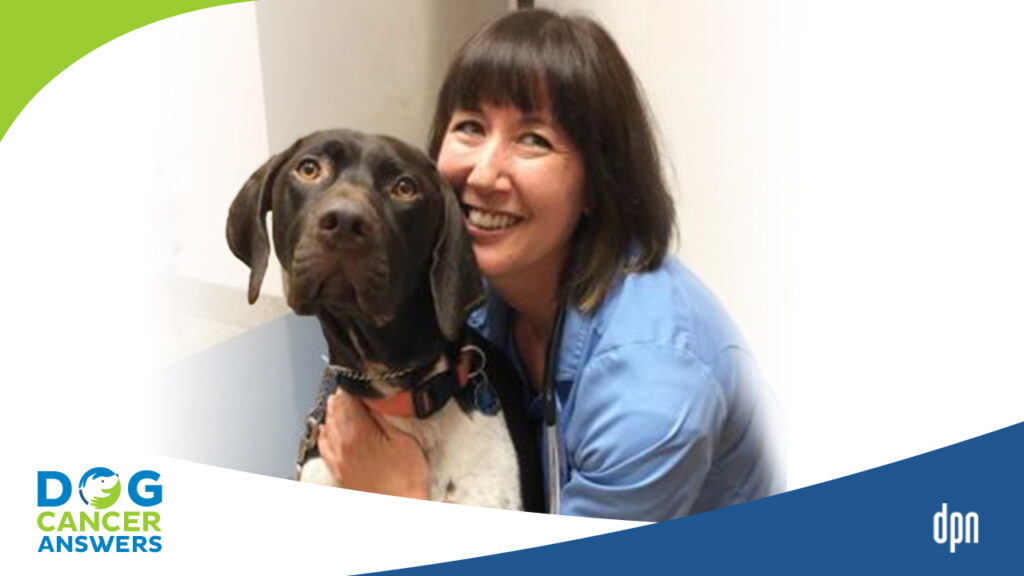EPISODE 186 | RELEASED October 3, 2022
What Is Futile Care in Veterinary Medicine? | Dr. Nathan Peterson
Dog cancer treatment decisions are rarely easy. And they can be as hard on veterinarians as they are on owners.
SHOW NOTES
Researchers from Cornell University surveyed over 400 veterinarians, and 99% of them said they have experienced clients wanting to pursue futile care for their pets. So what is futile care, anyway?
Futile care is continuing aggressive treatment when it is unlikely to benefit the patient. These scenarios can be difficult to identify and define, but can be distressing for veterinarians who are compelled to provide care that they feel is prolonging suffering in their patients.
Listen in to learn more about the challenges of balancing the needs and emotions of dogs, their owners, and their veterinarians. And if you feel like you might have pursued futile care with one of your pets when hospice would have been more appropriate, don’t be too hard on yourself: all of your decisions were made out of love.
Links Mentioned in Today’s Show:
Medical futility is commonly encountered in small animal clinical practice study
[00:00:00] >> Dr. Nathan Peterson: Now an approach that I take that might maybe capture a little bit more of that nuance is to ask owners, if you were writing a narrative, or if you were writing your pet’s story, it’s life story, what would the final chapters look like? How would you write the death of your pet?
[00:00:22] >> Announcer: Welcome to Dog Cancer Answers, where we help you help your dog with cancer.
[00:00:28] >> Molly Jacobson: Hello, friend. As dog lovers, most of us here at Dog Cancer Answers are very passionate about getting treatment when our dogs get sick. That’s usually what we talk about here. But in every dog’s life, there comes a point where there are no longer any good options that can actually help us achieve the goals we have for their health.
Pursuing care beyond that point doesn’t really benefit the dog, and it’s called futile care. To help us unravel what futile care is and how it impacts us, our dogs, and the veterinary care team who are helping us, we’re joined by Dr. Nathan Peterson, one of the authors of a recent study looking at futile care in veterinary medicine.
Dr. Peterson, thank you so much for coming on the show today.
[00:01:13] >> Dr. Nathan Peterson: Thank you.
[00:01:15] >> Molly Jacobson: So we were just talking about how often dog lovers who are dealing with dog cancer are navigating a really emotional, troublesome terrain. They have a lot of questions. They have, often have a lot of very intense feelings of shame and guilt about even having to deal with it in the first place.
A lot of people blame themselves, and I imagine that they bring all of that kind of emotional intensity right into the exam room with veterinarians, and I’m sure that is a lot for, not only the dog lover, but the veterinarian and the staff at the hospital to cope with. I know you’ve done a lot of thinking about this topic of how do we care for dogs in extreme circumstances, and how do we balance all of the competing interests in those circumstances. And I’m wondering if you could just tell us a little bit about the survey that you recently did of veterinarians.
[00:02:14] >> Dr. Nathan Peterson: Yeah. So I think you’re exactly right. You know, end of life discussions, regardless of what the underlying disease is, are always challenging. And I think dogs with cancer, those conversations can maybe be even a bit more challenging because sometimes owners have time to think about it. And oftentimes owners have personal experience with cancer in previous pets or with their own human loved ones. So it’s, it’s a topic that I think people have spent a lot of time thinking about.
What I was particularly interested in, and the survey that we conducted, was really looking at the frequency of what, for lack of really better terminology, we sort of call futile care. So, um, what I mean by that is providing ongoing aggressive care, generally, to pets when we have no real expectation on the medical side that further treatment is gonna benefit them at all.
And you know, as, as you mentioned, there is a lot of emotion involved and, and certainly veterinarians and our technicians and nursing staff get involved in this career and profession because they really love animals and they want to help them. And it can be quite distressing when we feel like maybe the care that we’re providing is prolonging suffering rather than ameliorating suffering.
[00:03:40] >> Molly Jacobson: How often does that happen, would you say?
[00:03:44] >> Dr. Nathan Peterson: That’s a tough question. Based on the survey results that we have, the majority of respondents, over half, said that it happened frequently – and we sort of defined that as more than six times per year – that they were facing situations where they felt that requests for treatment were being made that they really didn’t agree with.
[00:04:06] >> Molly Jacobson: And this was a survey of veterinarians themselves-
[00:04:10] >> Dr. Nathan Peterson: Yeah.
[00:04:10] >> Molly Jacobson: -about how often they’re put in a position of having to make a judgment call about, do I help this dog owner feel like they’re doing everything – or pet owner, do everything they can for their pet, or do I advocate for another decision to stop treatment perhaps, or let the dog or cat or pet go, because that’s really more kind to the animal in that specific case.
[00:04:37] >> Dr. Nathan Peterson: Yeah. We did survey veterinarians, you know, more specifically, the survey ended up targeting veterinarians who are mostly specialists.
[00:04:48] >> Molly Jacobson: Okay.
[00:04:48] >> Dr. Nathan Peterson: Some of whom were veterinary oncologists.
[00:04:51] >> Molly Jacobson: Okay.
[00:04:52] >> Dr. Nathan Peterson: Anecdotally, conversations with veterinarians who are not specialists, experience this also. And interestingly, we found that futile care, as we defined it, was not restricted just to care being provided in the hospital setting. It was happening at home as pets were being treated as outpatients. So I think that it really is a relevant topic for, for all veterinarians.
[00:05:15] >> Molly Jacobson: How many veterinarians did you survey?
[00:05:17] >> Dr. Nathan Peterson: I believe we ended up having over 400 respondents.
[00:05:21] >> Molly Jacobson: Okay.
[00:05:22] >> Dr. Nathan Peterson: Which, in terms of veterinary surveys, is, is a pretty good response.
[00:05:27] >> Molly Jacobson: And this was something you sent out like to your trade association, or how did you collect responses for this?
[00:05:32] >> Dr. Nathan Peterson: Exactly. We, we ended up distributing the survey to various professional organizations through listservs.
[00:05:39] >> Molly Jacobson: Okay. So people sort of on the behind the scenes in your veterinary networks saw this survey and decided to, to answer it if it felt like something they were called to contribute to. And it, was it anonymous?
[00:05:52] >> Dr. Nathan Peterson: It was, yeah.
[00:05:53] >> Molly Jacobson: So they felt comfortable really answering honestly, and like they weren’t breaking confidentiality or-
[00:05:58] >> Dr. Nathan Peterson: Yeah. And we didn’t ask for any specific examples or, or anything. I think really, we were pretty straightforward in just informing the respondents that we just wanna know if this is happening and if it is, how frequently is it happening?
[00:06:11] >> Molly Jacobson: Okay. And so, over 400 veterinarians answered the survey and said that it’s happening about six times a year, where they’re faced with this real dilemma of offering what you’re calling futile care, meaning – I guess to me that means, as a lay person, that you know that my dog does not have that much more time, and that any kind of aggressive treatment is not going to give me the result I’m hoping for. And you have to make that decision to continue with that care, even though it’s quote, futile.
[00:06:44] >> Dr. Nathan Peterson: Yeah. I think a couple of points that I, I would bring up, you know, I think in terms of frequency, we did have a majority of respondents say this happened at least six times per year in their practice. What we found though, is that virtually, I think over 99% of the respondents had indicated that they had encountered this situation during their career.
So it’s happening frequently for over half of the respondents, but nearly unanimous experience for all of our respondents. I think the other thing that you begin to touch on here, and I think that it’s an important distinction for us to draw really as we enter this conversation, is when I am talking about futile care and I think the futile care that the respondents were envisioning is really, as you describe, sort of aggressive care designed at trying to treat the underlying disease.
And I think it’s important that we draw a distinction here between that type of aggressive care to continue treating to try to beat a disease, distinguish that from hospice care or palliative care, which really is centered on eliminating some of the symptoms and signs and making pets comfortable.
I think that certainly palliative care and hospice are areas that are thankfully expanding in veterinary medicine. That’s not usually the type of care that’s causing distress.
[00:08:18] >> Molly Jacobson: Okay.
[00:08:18] >> Dr. Nathan Peterson: The type of care that I found and that we found in the survey that’s causing distress is requests for, you know, aggressive interventions that are likely to carry with them side effects or consequences.
[00:08:31] >> Molly Jacobson: So for example, somebody whose dog has failed multiple rounds of chemotherapy and, in just this hypothetical, the dog owner says, well, let’s try another one. Let’s try another. What else can we do?
Or a dog that maybe has had surgery to remove a tumor and there’s a re-ocurrence and there’s also metastasis and it just doesn’t look like this is going to be something that can be removed from the body, but requesting another surgery or like really pushing hard for more treatments that really have profound side effects and could actually reduce quality of life especially if they don’t pay off.
So six times a year is like frequent, in your opinion, right? Meaning six clients a year are asking for this kind of aggressive care.
[00:09:16] >> Dr. Nathan Peterson: Yeah. To me, what it means is that, you know, once every two months a veterinarian is faced with having a discussion or conversation with a client where they’re essentially advocating for euthanasia or for a deescalation in care.
And I consider that to be frequent because, you know, I think we in veterinary medicine are, are oftentimes maybe a little bit more comfortable on the other side of the, of the conversation, saying there’s more things that we can try. And to be in the position of saying we’ve tried everything and we think it’s time to stop, is maybe a little bit more distressing.
[00:09:56] >> Molly Jacobson: Oh, that’s interesting.
[00:09:57] >> Dr. Nathan Peterson: And like I said earlier, certainly when we feel like we are contributing to ongoing suffering through our actions, that that really is bothersome.
[00:10:09] >> Molly Jacobson: So can you tell me a little bit about how that goes? Like what’s a scenario that, where a lay person, someone listening to this show, if someone’s listening to this show and thinking, Am I asking for futile care for my dog with cancer? Where’s the line? What would you tell them? How would they know that this is what they’re pushing for versus asking for appropriate care?
[00:10:32] >> Dr. Nathan Peterson: This is hard, and I think really resolving this dilemma is predicated on clear communication. So, hopefully what that client is hearing is an honest opinion from the veterinarian about what they think the likelihood is of success for further treatments, what treatment options realistically are available, and hopefully they’re hearing a veterinarian make recommendations that we deescalate care and really focus on patient comfort.
So if the client is hearing that clear communication and is saying, I, I acknowledge that, I recognize that you’re saying there’s nothing more that we can necessarily do, but I want to keep going, I think that would be the scenario when we might have the opportunity for some of that recognition that maybe we’re pushing the envelope too far.
[00:11:28] >> Molly Jacobson: Okay. So something that dog lovers often say is, my vet gave up on my dog.
[00:11:35] >> Dr. Nathan Peterson: Mm.
[00:11:36] >> Molly Jacobson: Do you think that they’re describing futile care, a futile care situation when they say that, that they’re actually talking about one of these situations?
[00:11:44] >> Dr. Nathan Peterson: That’s interesting, and I would love to hear or explore more about this from the client perspective. I suspect you might be right that, you know, when a veterinarian says there’s nothing else that we can do, it’s time to stop, an owner might, might interpret that as my veterinarian is giving up, and you know, I think that that’s sort of where that clear communication comes in. Absolutely.
[00:12:10] >> Molly Jacobson: It’s so hard, right? Because I’m imagining myself as a veterinarian and feeling very confident about the limitations that I’m facing as a practitioner, and then the grief that this client is going through as they come up against that "no." I would imagine that it feels incredibly distressing.
In fact, I wonder if this is not creating almost a moral injury for the veterinarian and their staff if they sort of have to continue to give care to an animal in an assertive way that they feel is not actually in the animal’s best interests. And a moral injury as defined by psychologists when they apply to like somebody who, who is in war and has to kill another human being.
And yes, they’re doing it because they think it’s the right thing to do when they’re fighting for their country, but they still carry that with them for the rest of their life. That’s a moral injury. Something that hurts your soul in a way.
[00:13:13] >> Dr. Nathan Peterson: Yeah.
[00:13:13] >> Molly Jacobson: And is that the level of distress that veterinarians are under when they’re facing these situations?
[00:13:20] >> Dr. Nathan Peterson: Absolutely.
[00:13:21] >> Molly Jacobson: So it’s pretty serious.
[00:13:22] >> Dr. Nathan Peterson: It, it is. And, and my co-author has actually, she did a study that preceded the current one, and they documented that, in fact, this does cause a great deal of moral distress to veterinarians. More so than having discussions about owners with financial limitations. This was the number one sort of moral distressor.
[00:13:44] >> Molly Jacobson: Wow.
[00:13:45] >> Dr. Nathan Peterson: And, you know, what we consider moral distress is, or a moral dilemma is, you know, knowing what the right thing to do is and not being able to do it for your own morals. And certainly, you know, veterinarians who are providing care that they don’t think is right, they carry that with them. Absolutely.
[00:14:04] >> Molly Jacobson: How do you balance that? How do you balance between, what does the veterinarian do? Is there a point at which you really kind of put your foot down as a veterinarian and say, I can’t treat your dog anymore, I can’t do this, I don’t think it’s right.
[00:14:17] >> Dr. Nathan Peterson: Certainly that happens. I think that, you know, based on the results of our survey, I don’t think that happens very frequently.
[00:14:26] >> Molly Jacobson: Okay.
[00:14:26] >> Dr. Nathan Peterson: So we had virtually 100% of veterinarians saying that they had provided this type of care. We had a strong majority saying that they believed that providing this type of care did not benefit the patient at all, but benefited the pet owner in some way by providing time for closure, by providing reassurance that everything had been tried. So balancing requests and refusals for requests of care, based on our results, it would seem that refusing to provide what we term futile care is, is actually infrequent.
[00:15:06] >> Molly Jacobson: Okay. So that’s really – veterinarians don’t like to do that. They don’t like to say, No, I’m not going to provide this care.
[00:15:13] >> Dr. Nathan Peterson: Yeah. I think that that’s, that’s also distressing, right? You, you have a relationship with a pet owner, you have a, in most circumstances or many circumstances, you have a longstanding relationship with the pet also.
[00:15:25] >> Molly Jacobson: Right.
[00:15:25] >> Dr. Nathan Peterson: And I don’t think that any veterinarian really wants the end of a lifelong interaction to be, I’m not gonna provide you care at the end of your pet’s life. So I think that, you know, we feel an obligation to provide that care maybe for a couple of reasons. One is, is just that relationship that we have with the clients and the pets.
The other obligation or the other pressure to provide care might stem somewhat from the the legal status of pets in many states, where they’re considered to be property. And I think that that leaves veterinarians feeling that they can’t realistically refuse treatment options because ultimately the pet is the owner’s property and they get to decide what type of care it receives. So I think that, you know, we’re experiencing a little bit of that pressure also.
[00:16:17] >> Molly Jacobson: That’s interesting. So just like the mechanic can’t tell you that you shouldn’t, you know, like replace the the engine on that old car because it’s not gonna be worthwhile, the veterinarian can’t say to someone, possibly, if they were pushed, under the law and it was reviewed in a court, couldn’t actually say, No, I’m not going to care for your dog. That’s interesting.
[00:16:41] >> Dr. Nathan Peterson: The veterinarians retain the legal right to say that we’re not gonna provide it, but I feel that that pressure still is there. That if I don’t provide it, they may go someplace else and find somebody else who will provide it. And I think I can provide it at a higher level or I already have a relationship with this client and, and pet, and.
[00:17:00] >> Molly Jacobson: I wanna be there for that dog or that cat, or yeah, I wanna be there for them. I don’t want to abandon them at this time because these are people who are in need, I mean, they are in need.
[00:17:10] >> Dr. Nathan Peterson: Yeah, absolutely.
[00:17:12] >> Molly Jacobson: On an emotional level. I mean, there’s nothing that I wouldn’t do to stave off the end of my dog’s life on a theoretical level. On a practical level, you know, I’d like to think that I’m able to accept the reality.
[00:17:27] >> Dr. Nathan Peterson: Yeah.
[00:17:27] >> Molly Jacobson: But I can absolutely understand someone who is just feeling overwhelmed at the whole thing and can’t quite think straight at that moment in the veterinary clinic and in the office. What are some sort of red flags that our listeners could have in their minds? Like is there anything that they could set up for themselves, like as a goal, to make sure that like, if this happens, I’m not going to take this action, or if this happens, I am going to take that action. Or like, what do you suggest our listeners do in order to guard against this possibility?
[00:18:04] >> Dr. Nathan Peterson: You know, I think that it’s challenging for me to lay out a set of what I would say are absolute red flags or lines to not cross. Because what we found is that the top two reasons that veterinarians provide futile care were, one, to provide an opportunity for an owner or a family member to be present for that pet’s death.
[00:18:27] >> Molly Jacobson: Oh, okay.
[00:18:28] >> Dr. Nathan Peterson: And I think that, you know, based on our definitions, we, we would say continuing care during that time didn’t really benefit the pet, maybe or maybe not, but absolutely provided a benefit to the client or the pet owner. And I don’t think that that type of care is necessarily distressing for veterinarians.
[00:18:47] >> Molly Jacobson: Okay.
[00:18:47] >> Dr. Nathan Peterson: I think that the reason I, I’d say I can’t definitively draw a line there is, you know, we sort of pose the rhetorical question of if I’m tasked with providing treatment for a pet for two hours while somebody arrives from work, you know that’s one thing, but it’s a different thing if I’m tasked with providing care for three weeks until a child can be home from school on break to be present.
So, you know, that’s why I say I don’t, don’t know that there’s necessarily a clear red flag. My suggestion would be to, on the part of both parties, the pet owner and the veterinarian, to really open up the conversation honestly, talk about what their specific goals are and exactly what they think the best course of action is.
I think approaching these types of conversations, when I’ve had them with clients, reassuring them that we’re, we both want the same thing, right? We both ultimately want their pet not to be suffering. Sometimes what the pet owner wants is they, they really don’t wanna be put in that position at all. It’s, it’s not fair that their pet is dying and, and they want a pet that is disease free.
And I think that we’re sympathetic to that, but unfortunately that’s just not a reality that’s possible many times. And so if we can come together and recognize that we’re both fighting for the same thing and that’s to relieve the suffering of a pet, then I think it’s easier to find common ground and come together as a team and decide, you know, how we’re gonna proceed.
[00:20:28] >> Molly Jacobson: Do you think that when these situations arise, the owner may not be aware of the suffering of their pet?
[00:20:37] >> Dr. Nathan Peterson: I do think that that’s possible and, interestingly, now that you mentioned it, the third most common reason that veterinarians provided futile care in our survey was because they believed the owner didn’t understand the pet’s prognosis. So I think that there certainly is a component of that. I think that depending on how long a veterinarian has been in practice, they may have different comfort levels talking with owners about suffering.
Again, this is for me, where I find just honest, open communication works the best. And I think having a conversation specifically focused on what is suffering, what does suffering look like, with a client who’s struggling with a decision, having that conversation with a veterinarian is beneficial. Because I think that we recognize there are many different ways to suffer. You know, suffering doesn’t have to just be intractable pain. Suffering can come in many different forms.
So I think if I was giving advice to an owner who was concerned that they were maybe going too far, I would encourage them to just have that, ask that question: do you think my pet is suffering? Recognizing that suffering comes in many different forms.
[00:22:00] >> Molly Jacobson: Could you list some of those for our listeners so they understand more about what you think constitutes suffering on the part of an animal so that they can maybe expand their vocabulary a little bit? I think a lot of people think, they ask, Do you think she’s in pain? And that’s what they consider to be suffering. But it sounds to me like you’re saying no, that’s one kind of suffering, but there other, other sufferings. What are those?
[00:22:27] >> Dr. Nathan Peterson: Yeah, so suffering is such an individual experience. But what I would say, and, and I agree with you, the question I often get is, do you think they’re in pain? And oftentimes, I don’t necessarily think they’re in pain, but I do believe they’re suffering. So the way that I sort of explain it is, you know, try to imagine the worst flu you’ve had or the worst cold you’ve had, and you might not be in, in severe pain, but you sure don’t feel good.
So I kind of look at that and I, I would consider, you know, maybe suffering looks like I’m nauseous. I don’t want to eat. I’m vomiting, I’m having diarrhea every time I go to the bathroom, or I’m straining to urinate or something like that. I can’t eat or I just don’t feel like it. So I, I think that this is where we sort of get into these gray areas and, and recognize that there are different aspects of suffering.
If, if I can’t do the things – and not to anthropomorphize too much, but if I can’t do the things that I like to do or I want to be able to do in my life, you know, at some point we would say, Yeah, that’s suffering.
[00:23:35] >> Molly Jacobson: Yeah. And especially, it’s one thing if it’s for a day or two, you know, diarrhea for a day or two, it’s suffering, but it’s only a day or two. But if we’re at the end of life and maybe they don’t have pain, but they’re going to have diarrhea from now until the end, whenever that is, that’s a form of suffering. That certainly would be for me.
[00:23:55] >> Dr. Nathan Peterson: Yeah.
[00:23:55] >> Molly Jacobson: I would not enjoy that. That’s not high quality of life.
[00:23:58] >> Dr. Nathan Peterson: Exactly.
[00:23:59] >> Molly Jacobson: I see what you’re saying.
[00:24:00] >> Dr. Nathan Peterson: Or, you know, we can continue treatment, but the side effect of this treatment is gonna be nausea and it’s gonna, you know, be that as I’m giving you these treatments, you don’t feel good. My own anecdotal experience with one of my cats that was sort of eyeopening was she had sort of a – still and we, we never established a definitive diagnosis, but we believe she had some sort of bone marrow cancer and she was transfusion dependent and we were giving her blood transfusions about every two or three weeks and giving her oral medications.
And, you know, then it was harder to find her to give her medication. So then it was, Well, we’re gonna, I’m gonna lock her in the bathroom so that I know where she is so that I can give her her medications because she needs those medications. And, you know, she doesn’t like her dry food anymore, so now I’m gonna start giving her treats and such.
And finally, one day I sort of woke up and, and looked, and I said, what am I doing? You know, I have my cat locked in the bathroom and she doesn’t sit on my lap. She doesn’t come out and join the family. I come in there and I give her some medications, sit with her for a little bit of time. And that realization that I, I was at that point continuing treatment for myself and not for her, was sort of a moment of clarity.
And having been through that and having had hundreds or thousands of conversations with clients and owners about suffering and and end of life, I recognize that sometimes it’s really insidious and it’s hard to recognize when suffering begins. You know, it’s one thing for me to see a pet come in and I have no, I’ve never seen them before in my life, and I can say, Oh wow, you are in a condition that to me wouldn’t be acceptable.
But that condition developed over the course of months to potentially years. And so, you know, at what point did that pet begin suffering, I don’t know that we can answer that. But I, I recognize the challenge of identifying it because it, it does happen slowly and, and insidiously.
[00:26:11] >> Molly Jacobson: Yeah. And if you continue down the treatment path, you can find yourself as you did, kind of going, Oh wait, my cat’s in jail and I’m her jailer, and that’s not exactly what she wants or what I want for her. And so it sounds to me like the best advice is to tune in to the experience that you think your pet is having, it sounds like, to me. To kind of imagine what it’s like on their day to day basis so that you can assess, is this good quality of life? Is this the life my dog wants for herself or himself? And, um, you have to guess, but at least you get an idea of where you are in that gray area.
[00:26:54] >> Dr. Nathan Peterson: Yeah.
[00:26:55] >> Molly Jacobson: How close you are to futile care versus supportive hospice care.
[00:26:59] >> Dr. Nathan Peterson: Yeah, and you know, I think that when I was younger in practice, you know, what we would do or how I would, would coach or council owners was say, Hey, make yourself a short list of things that you know that your pet really enjoys to do. And if you’re finding that they’re unable to do the majority of those things, then maybe the quality of life they’re experiencing isn’t what we want. And I think that that tool can be useful, but I don’t think that it captures the nuance that is present in situations where owners are struggling to make a decision about end of life.
So I think now, an approach that I take that might maybe capture a little bit more of that nuance, is to ask owners: if you were writing a narrative or if you were writing your pet’s story, its life story, what would the final chapters look like? How would you write the death of your pet? And sort of try to generate a mental image of what you think a good ending to your pet’s story would be, and sort of use that as a barometer to, to decide, am I sticking to my pet’s storyline or narrative, or am I straying from the narrative that I think that they would want.
[00:28:15] >> Molly Jacobson: I love that. That is an excellent piece of advice. Because these are murky waters, so we can only rely on our own judgment about our pet’s life and our experience with them to make these decisions. And telling us a story is something we can all kinda understand. I think human brains are story oriented, right? So I love that.
I think this is a good time to take a break, so we’re gonna listen to some of our sponsors and we’ll be back in a moment with Dr. Peterson to continue this conversation.
We’re back with Dr. Nathan Peterson discussing futile care in veterinary medicine.
Dr. Peterson, are there any resources for veterinarians, and then are there any resources for dog lovers, that you would recommend they consult if they are facing these sort of really tough decisions and wondering more about like how much is too much? Both for the layperson and also for veterinarians to deal with the moral injury they’re sustaining as a normal course of doing business.
[00:29:26] >> Dr. Nathan Peterson: Yeah. In terms of resources to point veterinarians to, unfortunately there just aren’t a lot at this point. You know, the conversations around moral distress are becoming more common, and that was one of the goals of our study was to really sort of open up this conversation within the profession, sort of get it out into the light so that people will start talking about it.
Right now, veterinarians tend to go to other veterinarians to have these discussions, whether they’re veterinarians within the same practice or friends from vet school or something like that. Resources for pet owners, you know, I think that what I would encourage is for pet owners to look for support groups.
You know, I think that your podcast is one of them, right? It’s, it’s a place where people can identify others going through a similar experience and they can talk about it. And those support groups can be present online, many times veterinarians will have resources for local in person support groups and grief counseling. So I would encourage owners to ask their veterinarian, Do you know of any groups that I can reach out to, or are there people meeting that that I can talk with about this experience?
[00:30:44] >> Molly Jacobson: I love it. Thank you so much for this important work that you’re doing and being part of that, opening up this conversation. It sounds to me like you’re increasing empathy for animals human and non, and I appreciate that very much.
[00:30:58] >> Dr. Nathan Peterson: Yeah, thank you. You know, I’m hopeful that, like I said, we generate a conversation. And I think that it’s most important again, that we just recognize that we are all striving for the same goal, and that’s to alleviate suffering. And we absolutely want the best thing for your pet just the same as you do.
[00:31:17] >> Molly Jacobson: Of course. Thank you so much for joining us today, Dr. Nathan Peterson. I’ll make sure that we have, uh, links to the things that we’ve talked about in the show below, including the links to the actual study itself and, so people can read that if they’re interested in it. I appreciate you joining us today.
[00:31:33] >> Dr. Nathan Peterson: Yeah. Great. Thank you.
[00:31:35] >> Molly Jacobson: And thank you listener for being here today. Because this was such a complicated topic, I decided to bring in our producer and licensed vet tech, Kate Basedow, to break it down a bit. Kate, thanks so much for joining me today.
[00:31:50] >> Kate Basedow: Thank you for inviting me again.
[00:31:52] >> Molly Jacobson: Of course. I think your exper- I hear your finches in the background. They’re so cute.
[00:31:58] >> Kate Basedow: Oh yeah. I forgot to put them out of the room this time. So we got a little bird song.
[00:32:02] >> Molly Jacobson: That’s okay. It’s bird song. Uh, maybe it’ll lighten up the topic ’cause what a heavy, complex-
[00:32:09] >> Kate Basedow: Yeah. Really.
[00:32:09] >> Molly Jacobson: -topic this is, this concept of, I mean, futile care itself, that, just that phrase is oh, so sad.
[00:32:17] >> Kate Basedow: Yeah. I really appreciate the delicacy with which Dr. Peterson discussed all the different nuances to these situations because you’ve got so many living beings that feel and think and experience these traumatic and sad situations, and balancing the needs and wants of the pet who’s sick, and depending on the condition it might be something that can definitely be treated or something that maybe can be treated or something that can’t be treated, and just doing either supportive care or propping them along. And then balancing all of that, as if that isn’t bad enough, with the owner who loves and adores this pet and has been caring for them for their whole life, trying to wrestle with the grief of maybe losing them and make decisions about what treatment options to pursue, or what diagnostics to pursue, or whether it’s at the end and time for euthanasia.
And then on top of that, the veterinarian and the staff who are also looking at this animal, and because of their profession and dedication to animals, they’ve got the Hippocratic Oath talking in the back of their heads saying, "First do no harm," and also wanting to see this pet feel better, and also wanting the owner and the client to feel fulfilled and to feel like they’ve done everything that they could and that they’re making the right choice for their pet. It’s hard.
[00:33:59] >> Molly Jacobson: It’s so murky. And you know, I couldn’t help but keep thinking as, as Dr. Peterson was talking about how complex the experience of a dog lover, a pet owner, often is, because by the time we’re in this kind of situation, completely, depending on the case, I mean, all of these, everything we talked about today has to be seen as a case by case basis. There-
[00:34:24] >> Kate Basedow: Oh, for sure.
[00:34:25] >> Molly Jacobson: -aren’t really universal rules, right? Except I think, universally, people who love their animals are in shock, in grief, and feel guilty. Like, whether it’s their fault or not, doesn’t really matter.
[00:34:41] >> Kate Basedow: Yeah.
[00:34:41] >> Molly Jacobson: Because animals kick in all of our evolutionary and biological parental instincts. And so just like a mother will always feel guilty if their child is sick, it’s hard for us, our primate brains, to look at a dependent animal of another species and say, That animal is completely dependent on me for everything, and now they’re sick. It automatically, I think, kicks up guilt in us, and that can really cloud our thinking.
[00:35:12] >> Kate Basedow: Absolutely.
[00:35:13] >> Molly Jacobson: And our ability to just accept the situation as it is – so the veterinarians, the vet techs, they have a certain perspective that’s not just medically informed, but also has that emotional distance of like, I can see the situation, you know, from their perspective, possibly more clearly than we can from our perspective as a guilt ridden primate clutching their baby.
[00:35:35] >> Kate Basedow: Yeah. And in many cases, the veterinarian and the technicians and other veterinary staff have already seen this movie.
[00:35:43] >> Molly Jacobson: Right.
[00:35:43] >> Kate Basedow: They’ve already seen what happens with a cat in kidney failure. They know how the progression can look, they’ve probably seen a couple different iterations of it. They’ve seen that dog in liver failure and what goes on, or the dog with osteosarcoma that isn’t able to have an amputation. They know what the end picture can look like and have that dread of what is coming.
And an owner, no matter how much – even being a veterinary technician, when something’s wrong with my own pets, a part of you completely loses rationality. You just want them to feel better. I was the owner who when my dog’s neck really hurt and she was screaming in the middle of the night anytime she moved, I gave her my other dog’s pain meds.
And I walked in the next day to work and I said to the vet, I said, I know, I know, I should not have done this. Because now the vet’s not seeing the same picture of the pain that was involved, and then it impacted what medications we could give her that day, we had to do a washout from the NSAID that I had given her before we could start her on pred to really get the problem under control.
But in that moment of my pet is screaming in pain, you kind of lose it.
[00:37:05] >> Molly Jacobson: Yeah.
[00:37:05] >> Kate Basedow: And that’s just a part of being human and loving someone.
[00:37:10] >> Molly Jacobson: Right. And so I think my big takeaway was actually that all of us need a lot more compassion in these situations than maybe we extend to ourselves. Like if you’ve been listening and you’re like, Oh my God – I was listening and I was thinking about several pets in my past, pets I’ve had, pets other people have had, where I think, oh, maybe that’s what was going on there. Maybe there was a little bit of futile care being requested.
And I have to really go back to that place of compassion saying, you can’t know. You know, not only can you not know because – so there’s the human primate just wanting the pain to end for their little, their little dependent. And then there’s also this positive mindset that at least here in the United States of America, we are inculcating with from birth of like, we can do it. Right? Like-
[00:38:03] >> Kate Basedow: Yep. There’s always that hope, ’cause there’s always outliers to everything. There’s always the exception to the rule. And we always hope that our dog is going to be the lucky one that has the miraculous recovery. And sometimes those do happen.
[00:38:18] >> Molly Jacobson: Yeah. And they do.
[00:38:19] >> Kate Basedow: Yeah. But you have to come into those decision moments – even if you do end up still deciding to pursue the heroic effort, you still have to have that rational thought in the back of your mind and recognize that this probably won’t work.
[00:38:39] >> Molly Jacobson: Right.
[00:38:39] >> Kate Basedow: And I think that’s a little bit healthier than just diving in being absolutely sure it’ll work, having realistic expectations. You don’t have to get rid of hope, ’cause hope is a great thing to have.
[00:38:51] >> Molly Jacobson: Oh yes.
[00:38:51] >> Kate Basedow: And sometimes everything does work out miraculously well, but I think we all need to get better when looking at our pets – and ourselves for medical decisions – think about both what we want to happen and what is likely to happen, and then see where those things overlap and try to make the best decision for us and our pet in that moment.
[00:39:15] >> Molly Jacobson: Right. And then later, when we’re beating ourselves up because it didn’t go the way that we wanted it to, if that’s the case, to let ourselves off the hook. Because in the end, we all make the best decisions we know how at the time with the information we have, and that’s a fact. ‘Cause if you’re in denial about something, sorry.
You know, like you can wake up like Dr. Peterson did with his cat, where all of a sudden he is like, Wait a minute, I’m my cat’s jailer. Like this is not what she wants for her life, what am I doing?
[00:39:43] >> Kate Basedow: Yeah.
[00:39:44] >> Molly Jacobson: He could look back and say, Oh, I’m a terrible person, but that’s not healthy either. Gotta give yourself a break. He was doing the best he knew.
[00:39:53] >> Kate Basedow: And as he said when we were chatting after recording, all of those decisions that we make, even if later we think that they were the wrong ones, we make them out of love. And our pets know that and-
[00:40:06] >> Molly Jacobson: Right.
Yeah. Don’t you think our pets know that, Kate? I think our pets know that we love them.
[00:40:11] >> Kate Basedow: Oh, they absolutely know. For sure.
[00:40:13] >> Molly Jacobson: Yeah.
[00:40:14] >> Kate Basedow: Sometimes they think we’re foolish. Like when I ask my dog to walk down the pier and walk by the boats and she’s like, This is not safe, mom. But they love us and they know wholeheartedly that we love them.
[00:40:29] >> Molly Jacobson: Yeah, I agree.
Well, thanks Kate for helping me talk through that really potent conversation with Dr. Peterson. I know that we have a lot of resources to offer people in our Facebook group, lots of people there who understand exactly where you are if you’re at this stage where you’re wondering, what should I be doing for my dog? So join us. You can go to dogcancersupport.com and that’ll redirect you to our Facebook group. Or if you’re on Facebook already you can search for Dog Cancer Support and we’ll come right up. Just click to join.
Don’t forget to like us on all the socials and subscribe to our newsletter, Dog Cancer News. That’s on DogCancerNews.com. You can go right there and sign up. And, uh, it strikes me that there will be people who have questions after this so let me give you our Listener Line. Our Listener Line is (808) 868-3200. If you have a question for a veterinarian, we’ll get it answered for you in a future show. Give us a call and leave your recording. (808) 868-3200.
I’m Molly Jacobson. And for all of us here at Dog Podcast Network, I’m wishing you and your dog a very warm aloha.
[00:41:50] >> Announcer: Thank you for listening to Dog Cancer Answers. If you’d like to connect, please visit our website at dogcanceranswers.com or call our Listener Line at (808) 868-3200. And here’s a friendly reminder that you probably already know: this podcast is provided for informational and educational purposes only. It’s not meant to take the place of the advice you receive from your dog’s veterinarian.
Only veterinarians who examine your dog can give you veterinary advice or diagnose your dog’s medical condition. Your reliance on the information you hear on this podcast is solely at your own risk. If your dog has a specific health problem, contact your veterinarian. Also, please keep in mind that veterinary information can change rapidly, therefore, some information may be out of date.
Dog Cancer Answers is a presentation of Maui Media in association with Dog Podcast Network.
Hosted By
SUBSCRIBE ON YOUR FAVORITE PLATFORM
Topics
Editor's Picks
CATEGORY










